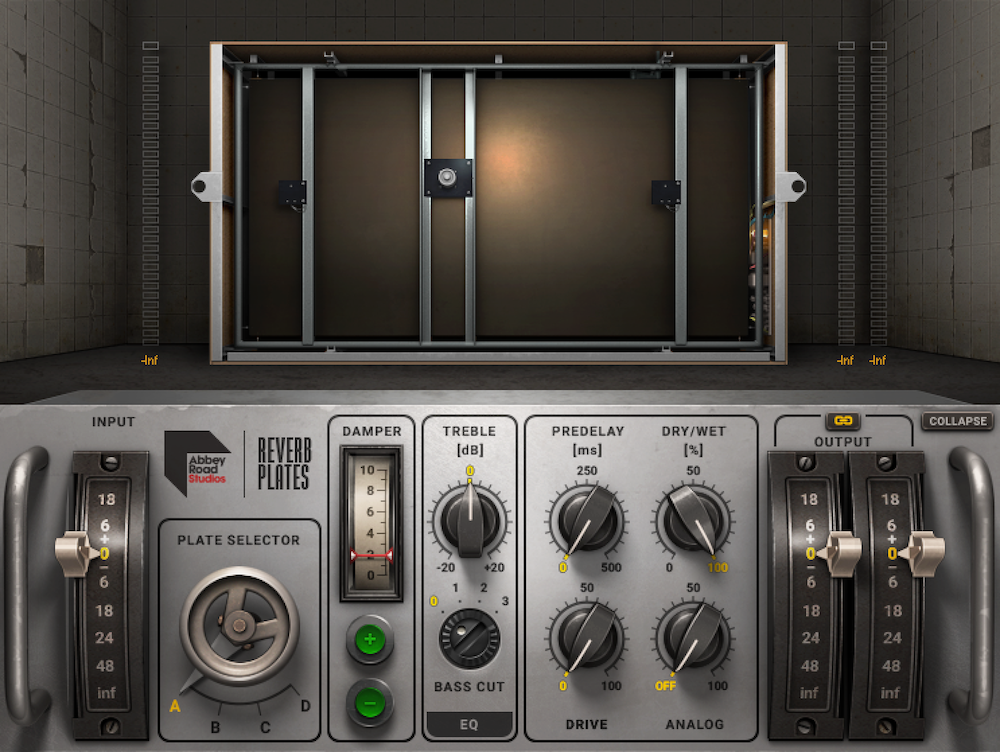If you’ve spent any time playing around with reverb in-the-box, you’ve probably observed the common types that exist. Chamber, hall, and room are easy enough to imagine, but what about plate reverb? We most easily associate “echo” with real-world spaces, but it can be created synthetically as well!
Plate Reverb Explained
Plate reverb was one of the first types of synthetic reverb to be developed. It worked by suspending a literal steel plate under tension with springs at the corners, and then attaching that plate to an outer shell. The plate would vibrate after receiving a signal from a transducer (an input signal), and that vibration would subsequently be picked up by another microphone in the unit (output signal). If you tap on any metal item large enough, you can understand the thought process behind plate reverb.
Plates were very popular when they were first developed, due in large part to being much less expensive and more practical than a dedicated echo chamber. They weren’t always small, necessarily, but were less invasive than the alternative! Plate wasn’t the only type of synthetic reverb at the time, however. Spring reverb was also used frequently, though plate tended to dominate up until digital reverb was developed.
And even though digital reverbs initially sounded even less natural than plate reverb, they were, again, a more practical alternative. Of course, with so much mixing done entirely in-the-box, digital reverbs rule today’s recording world, and they sound incredible! We can emulate virtually any sonic space imaginable, but we can also emulate plate reverb because of its distinct character that became a sound we grew accustomed to!
Uses for Plate Reverb
Color
Plate reverbs are great for adding perceived brightness to an instrument. If you’re wondering how, it’s because you can use plate reverb to take advantage of a psychoacoustic phenomenon called the precedence effect. The precedence effect basically means that we hear higher frequencies before we hear lower ones.
So if you add a plate to a vocal and leave the full frequency spectrum in, your ear will perceive those reverberated highs first. This makes the vocal appear brighter than it actually is!
Effect
Our ears are very adept at determining whether a sound is natural. Because of this, we instinctively know whether a reverb is coming from an actual physical space, or some place unnatural. Plate reverb is synthetic, and our ear knows this! But that’s okay, because plates can be used as an effect.
Mixing music isn’t always about realism! Depending on the material, sometimes the most outlandish and unusual sounds are the perfect fit for the track. Consider using plates when you aren’t concerned with creating a space that sounds “real.”
Blend It with Other Reverbs
It’s incredibly common to use multiple reverbs while mixing. If you mix from a template, for instance, you might already have chamber, hall, room, and plates set up and ready to go, adding a bit of each to taste as you mix.
Plates are great to blend with other reverbs, because they have a totally different quality from a dedicated space. On a totally dry track, you can pick a space, like a room or hall, and then augment that with plate instead of another room. This ensures you won’t be creating a “room within a room” vibe.
Think about it on drums. If they were recorded in a live space, you’ll have natural reverb already printed. Rather than adding a “drum room” reverb emulation to a real drum room, you can mix in some plate instead.
The Plate is Great
Cheesy rhymes aside, plate reverb is an excellent tool for a variety of purposes. It has a unique character in that it’s perceptibly “false,” making it a great creative effect! So if it seems counterintuitive to use something that isn’t a space to create space, try blending it with room reverbs like we mentioned above!
Whether you’re using it for a bit of brightness and color, enhancing an existing reverb with a bit of synthetic plate, or creating a surreal sonic landscape with wads and wads of plate reverb, have fun with it and experiment! It’s safe to say there’s no right or wrong way to do it.
